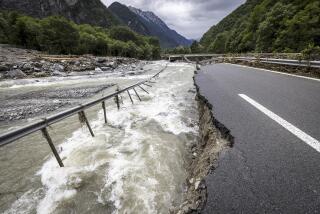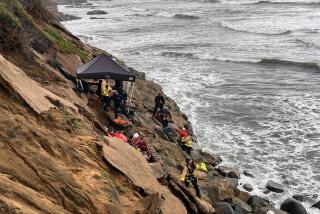Swiss Spelunkers Alive but Still Stuck in Flooded Cave
GOUMOIS, France — Eight Swiss social workers on a mission to test their mettle amid adversity spent a third night huddled on a chilly stone ledge in a cavern, still trapped today in an adventure-turned-nightmare as rising flood waters thwarted their rescue.
Divers had reached the hapless spelunkers from Zurich on Friday morning, bringing in hot food and ferrying out news that they were alive to loved ones standing vigil in this verdant outdoor recreation center.
But two other rescuers trying to deliver survival gear were forced to hole up with the Swiss after ground water swollen by torrential rain created an impenetrable current through the narrow, low-lying tunnel at the cave entrance.
“Everyone is astounded, even the specialists, about where the water is coming from,” said Peter Oberhaensli, Swiss consul stationed at the French city of Mulhouse, who has been the liaison between the 300-plus rescuers and the families of those trapped in the cave.
Generators and pumps brought in to remove enough water to allow the explorers to wade out with at least their heads dry were knocked out of order by the sudden rush of rainwater. By nightfall, the water level was higher than it had been in the morning, and despite the deployment of additional pumping equipment, there were no reliable forecasts of when the 10 people crowding the underground chamber might be freed.
“They are in remarkably good condition and spirits, now that they know they have been located,” said Francois Thierry, a psychological counselor from nearby Besancon, relaying what he was told by the first pair of divers.
Stymied by the so far losing battle to drain the flooded tunnel, rescue workers were considering bringing diving equipment to the tourists, who are trapped about 100 yards inside the cave, in the craggy mountains of France’s Doubs region on the border with Switzerland.
But that would be a last-ditch option because the inexperienced spelunkers have no diving training and the swim through utter blackness in a narrow tunnel against an unpredictable current would be far more dangerous than a few more hours in their elevated air pocket.
After sunrise today, Oberhaensli said the water level was still too high for the explorers to wade out themselves. The weather was hazy, but because there was no immediate threat of fresh rain, rescue workers felt no urgency to force the novices to swim out through the dark tunnel.
Early Friday, rescuers trying to drill through to another known air pocket were shattered to find the chamber empty. They feared that the Swiss were no longer alive. But divers sent to check a second possible refuge returned with the joyous news that all eight were in good condition.
The explorers--seven students and a trainer from the Zurich College for Social Workers--entered the nearly 1,400-foot-long network of caves and tunnels Wednesday. They were reported missing by a second group from the school, which had gone on a rafting expedition.
The outings were part of the school’s training, aimed at teaching students the value of cooperation and interdependence in difficult circumstances, Oberhaensli said. The eight Swiss include three women and five men, ages 23 to 35. One of the two male divers later trapped with them is a doctor, the Swiss diplomat said.
The tour was organized by Altamira, a travel agency in Bettingen, near Basel, Switzerland, that specializes in educational tours.
“The tension in the last 36 hours has been unbearable,” Altamira’s chief, Valentin Vonder Muehll, told Swiss-German radio DRS. “But I never gave up hope that they were still alive.”
Rescue workers have been at the site since late Thursday, but an overnight downpour prevented forays through the flooded entrance until daylight Friday. Rain continued intermittently through midday, hampering rescue efforts but not dampening spirits, said Michele Pacaut-Tronan, a medical relief worker on the scene.
The narrow, steep mountain road leading to the cave was jammed with rescue vehicles and cars carrying fresh crews of volunteers. Dozens of TV satellite trucks and motorcycle police officers weaving through the chaos at high speed added to the confusion--a contrast to the serene wooded wilderness and star-studded skies.
“Our pumps are flooded. . . . Only three of 12 are working at the moment,” said rescue worker Eric Zipper, exuding frustration at the steadily rising water that was being pumped out at 1,600 cubic meters per hour but not keeping pace with the current.
Alain Gehain, governor of the surrounding Franche-Comte region, told journalists that the explorers were “very weak” but in good spirits once provided with warm food and insulation against the cold and damp.
He had appeared to chastise the tourists earlier in the day when he said heavy rain in the region should have been a warning to the novice explorers not to risk the expedition.
“Those who know the region’s caves well are not going inside at the moment,” he said, noting that rainfall has been 80% higher this year than last.
More to Read
Sign up for Essential California
The most important California stories and recommendations in your inbox every morning.
You may occasionally receive promotional content from the Los Angeles Times.











